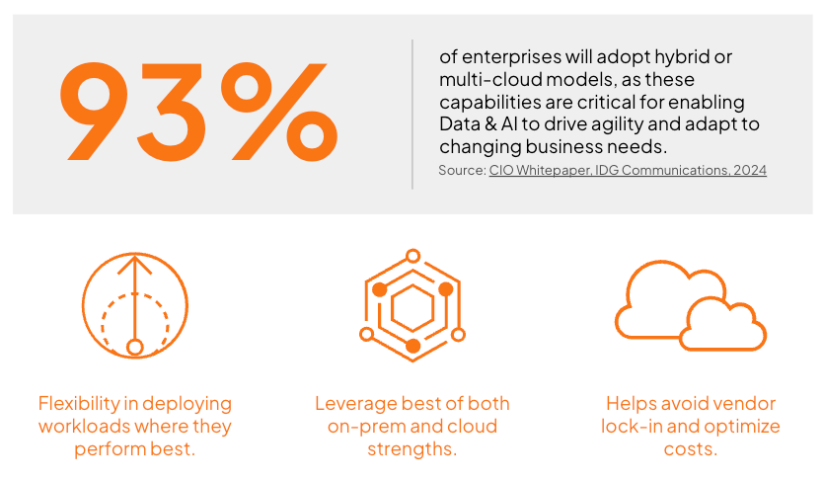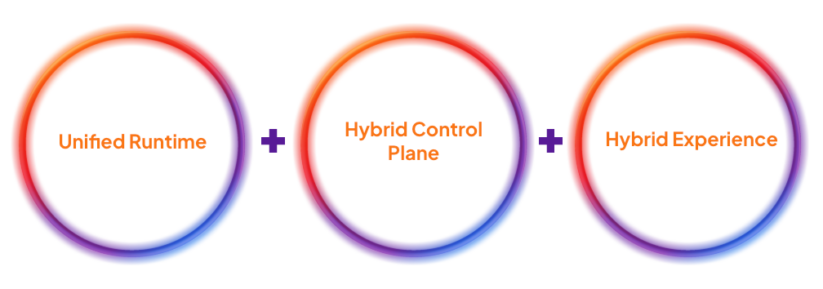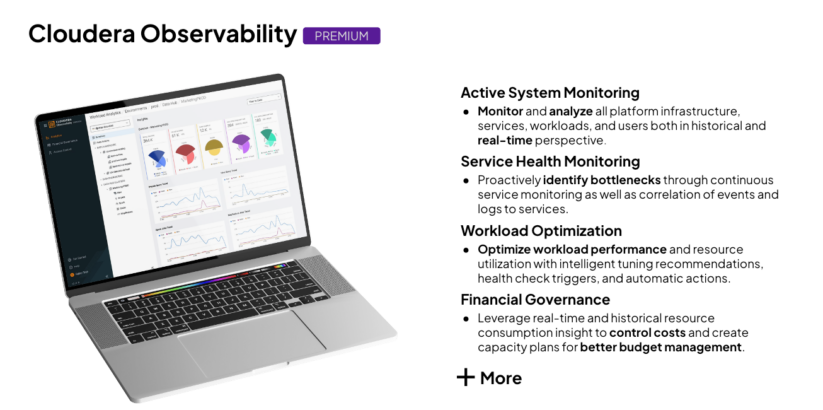In today’s dynamic digital landscape, multi-cloud strategies have become vital for organizations aiming to leverage the best of both cloud and on-premises environments. As enterprises navigate complex data-driven transformations, hybrid and multi-cloud models offer unmatched flexibility and resilience. Here’s a deep dive into why and how enterprises master multi-cloud deployments to enhance their data and AI initiatives.
The terms hybrid and multi-cloud are often used interchangeably. However, for clarity and consistency, we will use hybrid throughout the text. While multi-cloud generally refers to the use of multiple cloud providers, hybrid encompasses both cloud and on-premises integrations, as well as multi-cloud setups. This holistic approach better reflects the flexibility and strategic advantages discussed herein.
Why Hybrid and Multi-Cloud?
Adopting hybrid and multi-cloud models provides enterprises with flexibility, cost optimization, and a way to avoid vendor lock-in. In fact, recent research suggests that 93% of enterprises will adopt hybrid or multi-cloud models in the near future. This will allow companies to deploy workloads in environments where they are best placed, balancing on-prem and cloud advantages to maintain agility and meet evolving business demands.

Image: The Importance of Hybrid and Multi-Cloud Strategy
Key benefits of a hybrid and multi-cloud approach include:
- Flexible Workload Deployment: The ability to place workloads in environments that best meet performance needs and regulatory requirements allows organizations to optimize operations while maintaining compliance.
- A prominent public health organization integrated data from multiple regional health entities within a hybrid multi-cloud environment (AWS, Azure, and on-premise). This approach enabled real-time disease tracking and advanced genomic research while ensuring compliance with stringent privacy regulations like HIPAA. Leveraging Cloudera’s hybrid architecture, the organization optimized operational efficiency for diverse workloads, providing secure and compliant operations across jurisdictions while improving response times for public health initiatives.
- Cost Savings: Hybrid and multi-cloud setups allow organizations to optimize workloads by selecting cost-effective platforms, reducing overall infrastructure costs while meeting performance needs.
- A leading meal kit provider migrated its data architecture to Cloudera on AWS, utilizing Cloudera’s Open Data Lakehouse capabilities. This transition streamlined data analytics workflows to accommodate significant growth in data volumes. By leveraging the Open Data Lakehouse’s ability to unify structured and unstructured data with built-in governance and security, the organization tripled its analyzed data volume within a year, boosting operational efficiency. The scalable cloud infrastructure optimized costs, reduced customer churn, and enhanced marketing efficiency through improved customer segmentation and retention models. This modernization also provided a future-proof platform for advanced analytics and AI-driven insights, ensuring continued innovation.
- Risk Mitigation: By using multiple vendors, organizations can mitigate risks such as vendor lock-in, outages, and sudden pricing changes, ensuring operational resilience.
- Several organizations utilize multiple cloud providers—such as AWS, Azure, and Google Cloud—to enhance risk mitigation. This multi-cloud strategy helps prevent vendor lock-in, ensures compliance with various regulations, and bolsters resilience against potential service disruptions.
Role of a True Hybrid Platform
A well-integrated hybrid platform is essential for seamless data movement, governance, and workload management across environments. However, a few foundational components are needed to make this possible:
- Unified Runtime: Run applications and manage data seamlessly across environments without extensive rewrites.
- Hybrid Control Plane: A single management interface to oversee both cloud and on-premises deployments.
- Hybrid Experience: Effortlessly move workloads and data across clouds as business needs change.

Image: Aspects of a True Hybrid and Multi-Cloud Platform
A strong platform ensures that businesses can manage their multi-cloud environments effectively and with confidence, knowing that their data is secure, accessible, and compliant with regulations. Cloudera is the gold standard for hybrid and multi-cloud data platforms, offering enterprises a seamless, secure, and scalable foundation to manage their data and workloads across diverse environments.
Key Considerations for Data & AI Workload Placement
When deploying data and AI workloads across environments, certain factors can influence where they reside:
1. Data Security: It’s essential to safeguard sensitive information across environments using secure protocols and ensuring compliance. Balancing security with performance in a multi-cloud setup is paramount. Some best practices include:
- Zero Trust Architecture: Zero Trust Architecture combines explicit user verification with multi-factor authentication and least privileged access through fine-grained RBAC/ABAC policies.
- Data Encryption: Organizations encrypt data both in transit and at rest to prevent unauthorized access.
- Logging and Monitoring: Robust monitoring helps enterprises identify potential threats and performance bottlenecks across clouds.
2. Cost Optimization: Select cost-effective platforms and manage resources efficiently to minimize infrastructure costs.
3. Scalability: Choose platforms that can dynamically scale to meet fluctuating workload demands.

Image: Key Considerations for Workload Placement
Enhancing Hybrid Cloud Deployments with Observability
When you move to Hybrid and Multi-Cloud Deployments, you’ll see many components including containers, services, schedulers, and more – potentially deployed across many different infrastructures. Keeping such a complex platform under control and stable requires serious effort. When you need help from support to troubleshoot issues, most support tickets require multiple interactions to get the right context and information, which leads to frustration on the customer side.
Observability in a hybrid or multi-cloud setup ensures that your data and AI applications function optimally across environments. It helps prevent silos by offering unified views of performance and bottlenecks. This allows teams to proactively manage workloads, financial governance, and optimize resources. Cloudera offers a comprehensive solution that encompasses all these features.
Cloudera Observability helps organizations achieve efficiency and performance by enabling them to automatically analyze, manage, and improve deployments. Customers can maximize cost efficiency, enhance performance, and unlock intelligent insights with Cloudera Observability – a single pane of glass that provides visibility across hybrid and multi-cloud environments.

Image: Cloudera Observability Features
Leveraging AI and Machine Learning in a Hybrid Environment
A hybrid approach is ideal for deploying AI and ML. For instance, models can be trained in the cloud, leveraging scalable resources, and then deployed on-premises or at the edge for faster insights. This approach supports real-time analytics and end-to-end governance, ensuring consistency in AI models across environments. Leading enterprises have successfully adopted this strategy to enhance data access, security, and scalability.
Crafting a Hybrid Strategy for Enterprise Success
To implement a successful hybrid strategy, enterprises should:
- Assess Current Infrastructure: The first step is to assess your current infrastructure – understanding what you have in place, what workloads you’re running, and how they align with your overall business goals. This will help identify gaps and opportunities, allowing you to optimize for performance, cost, and scalability.
- Map Workload Placement: It’s important to map workload placement based on a ‘best-fit’ approach. Not all workloads belong in the same environment. For example, latency-sensitive applications might be better suited for on-prem or edge environments, while applications that require scalability could benefit from cloud environments. By strategically placing workloads where they perform best, you can improve efficiency and reduce costs.
- Ensure Portability: One of the most critical elements in a hybrid cloud strategy is ensuring portability for both data and applications. In a multi-cloud environment, you must ensure that workloads can move seamlessly between clouds without vendor lock-in. Leveraging containerization, Kubernetes, and other cloud-agnostic software will help maintain flexibility and agility as business needs evolve.
- Establish Governance: Lastly, don’t forget about governance, compliance, and security. As you expand across different cloud environments, it’s essential to establish clear governance policies that ensure compliance with industry regulations like GDPR or HIPAA.

Image: Steps for a Successful Hybrid and Multi-Cloud Strategy
Partnering for Hybrid Success
A successful hybrid strategy often benefits from partnering with experts. Cloudera, with its wealth of experience in hybrid and multi-cloud deployments, data, analytics, and AI, can accelerate an organization’s time to value, ensuring scalability, security, and seamless integration across platforms. Through Cloudera Observability, governance, and workload optimization, enterprises can turn their multi-cloud journeys into powerful assets for growth and innovation.
Embrace multi-cloud for strategic data and AI initiatives, and position your enterprise to be resilient, innovative, and competitive in an ever-evolving digital world.



